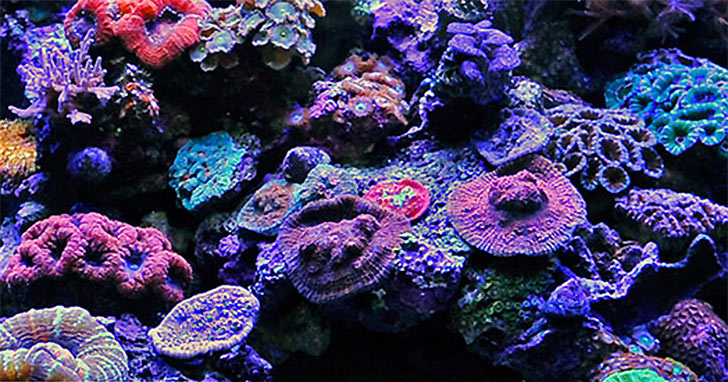
Whether you're establishing your first aquarium, or expanding your hobby experience with a new niche system, small aquariums, approximately 30 gallons or less, make a rewarding and relaxing project at home or in the office.
A nano aquarium's compact footprint make it a perfect fit for that empty corner or bare wall, and with the advances in multi-stage filtration and compact fluorescent lighting, maintaining a thriving freshwater or marine system is easier than ever.
Small-volume aquariums also demand special attention because changes in water quality, temperature, and fish stress levels become more pronounced in aquariums less than 30 gallons. With patience, research, and a little extra diligence, you too can create a beautiful, healthy nano-system. Here are some tips to get started:
-
Pick a Kit
- A hobbyist's best bet is to get a foolproof aquarium kit with integrated filtration and lighting built-in. That way, every component is a perfect fit, and you'll just need to decide on an appropriate heater. The most popular nano-sized aquarium kits include the classic Nano Cube Aquariums. These aquariums feature stylish bowfront designs with panoramic viewing.
- Place Wisely
- Though you may be tempted to position your compact aquarium on a desktop or office cabinet, remember that even a 12-gallon aquarium weighs over 120 lbs when filled! Invest in an appropriate aquarium stand that's built to bear the load and humidity. You'll be rewarded with peace of mind - and extra storage space too!
- Choose a Theme
- Focus your aquascaping and stocking plans around a specific region, species, or community grouping. This will make it easier to keep your water parameters on target for all inhabitants, and the familiar surroundings you provide - including shelter and breeding structures - will keep stress levels to a minimum.
- Stock Small & Sparse
- Restraint and patience are a small aquarium hobbyist's best friends. Avoid overpopulating your aquarium or you'll find water quality very difficult to keep viable. Also, when establishing a new system, introduce only a few fish at a time over several weeks - if not months. Select the smallest fish possible, building your community around a small school, one or two showcase fish, and a modest group of bottom cleaners.
Learn More >
- Go Live for Natural Filtration
- Let nature work for your aquarium's health. For best results with minimum external filtration, avoid artificial plants and structures. Instead, consider live plants and
eco-complete gravel for freshwater aquariums, and live rock or sand for your nano reef.
- Brighten your System
- Many hobbyists who want to see even better results in plant or reef growth choose to upgrade their lighting. Fortunately, retrofit kits and lighting upgrades are easy to find and install.
- Test/Observe Daily
- Small-volume aquariums experience accelerated cycles in water quality, making daily testing and observation an absolute necessity. Fish behavior - gasping, hiding, drifting, or darting - is your best indicator of other "invisible" health dangers to be concerned about. Also, keep some Test Strips near your aquarium for "ballpark" parameter checks. If some Nitrate, Nitrite, or pH levels concern you, zero-in on the problem with more accurate, pro-grade Test Kits.
Learn More >
- Frequent Partial Water Changes
- In nature, rain and water currents refresh water conditions by diluting and carrying away toxins before they can build up to excessive levels. The best thing you can do for your inhabitants' health is to change their water - 10% to 20% - once a week. This is especially important if you're pushing the population limit, or are keeping fish with larger bio-loads.
Learn More >
- Change Media Often
- To avoid the scourge of algae and to keep your fish healthy and stress free, change your
filter media according to the manufacturer's guidelines. If you're inattentive to regular filter maintenance, some chemical media, as it becomes exhausted and saturated, may begin seeping the excess toxins back into your aquarium!
- Act Fast When Problems Arise
- In small enclosed ecosystems, little problems become big problems fast. The bio-wheel you noticed has stopped turning, that little white spot on your Gourami, the Nitrite level which tested high... waiting even a day to take action could lead to your entire system crashing. Observe daily, test often, and always remedy the problems you discover within the same day. The health of your aquatic life depends on it!
BASIC
Often regarded as starter aquarium kits, these systems are suited for beginner hobbyists. They are a great way to introduce younger or new hobbyists to the fascinating world of aquariums. Generally under 10 gallons, these starter aquarium kits typically include an internal or hang-on power filter and an incandescent or mini-compact fluorescent lighting system. These budget-friendly kits are designed primarily for a freshwater, fish-only setup but can also be used by more experienced hobbyists to create miniature biotopes.
INTERMEDIATE
Starting at around the 12 gallon range (some even smaller!), these systems are extremely versatile. Intermediate systems generally feature upgraded lighting and filtration to accommodate a wider variety of inhabitants. Thanks to these enhancements, these systems are well suited as a small, freshwater community setup, planted aquarium, a saltwater aquarium or even a miniature reef aquarium. They are moderately priced, and offer a wide range of possibilities.
ADVANCED
Advanced systems are the ultimate in compact aquarium systems. Designed for unique biotope installations, many of these systems make nano reef installation a breeze. As the most comprehensive system, these advanced aquariums include various high-end equipment and many bonus features. One notable system is the 28G Nano-Cube WIFI AIO Aquarium. The included wavemaker, and other special features make it a dream system for nano reef enthusiasts (protein skimmer sold separately). Averaging at about a 28 gallon capacity, advance systems are also the largest of the compact systems. While these systems may cost more than the basic and intermediate models, they offer serious aquarium hobbyists a unique opportunity to create a truly breathtaking display.
|



